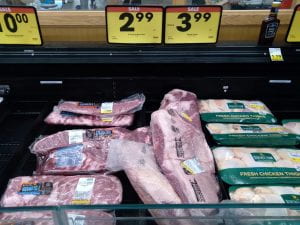 The Beef Reproduction Task Force and Texas A & M University will host the 2022 Applied Reproductive Strategies in Beef Cattle Workshop in San Antonio, TX on Aug. 30-31. The meeting will be held at the Westin San Antonio Riverwalk, 420 S Market Street, San Antonio, TX. Continue reading “Applied Reproductive Strategies in Beef Cattle Workshop in San Antonio, TX, Aug. 30 – 31”
The Beef Reproduction Task Force and Texas A & M University will host the 2022 Applied Reproductive Strategies in Beef Cattle Workshop in San Antonio, TX on Aug. 30-31. The meeting will be held at the Westin San Antonio Riverwalk, 420 S Market Street, San Antonio, TX. Continue reading “Applied Reproductive Strategies in Beef Cattle Workshop in San Antonio, TX, Aug. 30 – 31”
Category: July 2022
Beef Demand Matters!
By Glynn Tonsor, livestock and meat marketing specialist
 As society continues to transition from the pre-pandemic period and the many shocks that have occurred over the past couple years, it is easy to overlook a simple but critical fact – strong demand for U.S. beef has been supporting cattle prices! Published research points to cow-calf producers in particular accruing proportionally larger economic impacts from beef demand changes.[1] Accordingly, demand strength in recent years has supported feeder cattle prices and growing concerns in mid-2022 around beef demand strength are similarly worth monitoring, Continue reading “Beef Demand Matters!”
As society continues to transition from the pre-pandemic period and the many shocks that have occurred over the past couple years, it is easy to overlook a simple but critical fact – strong demand for U.S. beef has been supporting cattle prices! Published research points to cow-calf producers in particular accruing proportionally larger economic impacts from beef demand changes.[1] Accordingly, demand strength in recent years has supported feeder cattle prices and growing concerns in mid-2022 around beef demand strength are similarly worth monitoring, Continue reading “Beef Demand Matters!”
Consider Application Rates and Costs Before Ammoniating Wheat Straw
Justin Waggoner, Ph.D., Beef Systems Specialist, Garden City
Cattle producers often utilize crop residues such as wheat straw to sustain cows during drought conditions. However, the use of these forages is often limited by their low nutrient content and digestibility. The feeding value (crude protein, and dry matter digestibility) of straw may be enhanced by treating straw with anhydrous ammonia. Traditionally, a 3% application of anhydrous ammonia (dry weight) has been recommended (60 lbs anhydrous ammonia/dry ton hay). However, research conducted a K-State demonstrated that lower application rates (1.5% dry weight or 30lbs anhydrous ammonia/dry ton hay) produced proportionally greater improvements in both crude protein and in-vitro dry matter digestibility. Continue reading “Consider Application Rates and Costs Before Ammoniating Wheat Straw”
Livestock Risk Protection – What is price insurance worth?
By Jennifer Ifft, agricultural policy extension specialist and Sandy Johnson, Extension Beef Specialist, Colby
Livestock Risk Protection (LRP) is price insurance that pays out when market prices for feeder cattle (or fed cattle) are lower than expected. For example, if a producer calves in March and sells weaned calves around September, they can purchase LRP in March and “lock in” September futures prices. If by September, actual prices are lower than expected, they may receive a payment, or indemnity. Continue reading “Livestock Risk Protection – What is price insurance worth?”
Historical Perspective on Feedlot Cost of Gain
Justin Waggoner, Ph.D., Beef Systems Specialist, Garden City
The most recent edition of the K‐State Focus on Feedlots reported an average cost of gain of $119.97/cwt. and $134.44/cwt. for steers and heifers marketed in April, respectively. The average placed cost of gain was $138.25/cwt. for steers and $136.25/cwt. for heifers, with an average corn price of $7.95/bu. These values have prompted many to ask if these values are the highest cost of gains and placed cost of gains we have seen? Continue reading “Historical Perspective on Feedlot Cost of Gain”
The Current Labor Crisis
Justin Waggoner, Ph.D., Beef Systems Specialist, Garden City
“Good help is hard to find” and that old saying is truer today than it may have ever been. All industries, including agriculture, experience challenges in filling available positions on occasion. However, many seasoned managers indicate that they are struggling to even get applicants for positions. So, what are some of the reasons behind what is being referred to as the “labor crisis?” Continue reading “The Current Labor Crisis”